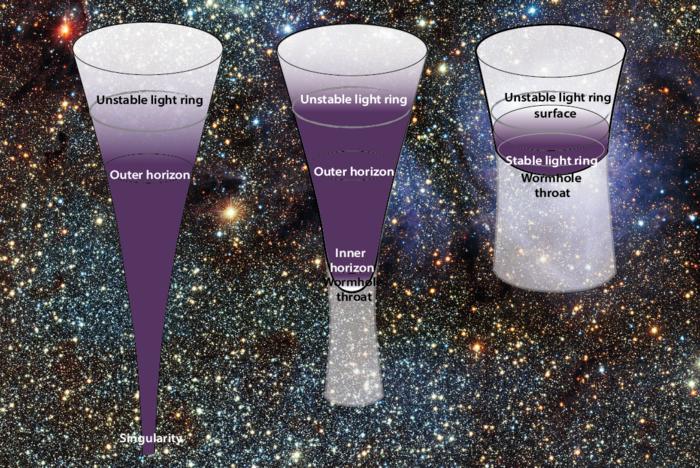Like a "singularity", where the laws of physics cease to apply, at the heart of black holes.
Though Karl Schwarzschild found an exact solution to Einstein's 1915 general relativity equations, which implied the existence of extreme objects now known as black holes, mass so concentrated that nothing — not even light — can escape their gravitational pull (thus "black"), the physics community remain unconvinced. For over 100 years many even found it problematic.
Maybe singularities are just math in some cases. Math is a language, languages can tell stories.

In one story, there is more than just one black hole, and two don't contain singularities at all. Credit: Sissa Medialab. Background image sourced from ESO/Cambridge Astronomical Survey Unit (https://www.eso.org/public/images/eso1101a/)
If spacetime curvature becomes truly infinite at the center of a black hole, and the laws of physics cease to apply, general relativity breaks down under extreme conditions. Part of that is no issue. Evidence for the existence of black holes is clear. Not just major milestones such as the 2017 and 2020 Nobel Prizes in Physics, but the first detection of gravitational waves in 2015, revealing the merger of two black holes, and the images captured by the Event Horizon Telescope (EHT) in 2019 and 2022.
Since 2015, scientists have detected gravitational waves from black hole mergers and obtained images of the shadows of two black holes: M87* and Sagittarius A*. Yet they provide no insight into whether a singularity lies at the center.
It's the Singularity that remains troubling. It's a modern Aether, some argue, the God of the Gaps, a blanket term for 'we have no idea.'
Knowing the unknowable
Scientists love mysteries because they hate mysteries. Physicists who ridicule social sciences receive a ready retort that they don't even know about 94% of the universe. So speculation has been rampant about how a singularity can exist with unlimited spacetime curvature. Like getting rid of the singularity entirely, or invoking quantum gravity.
A recent synthesis of discussions outlined three main black hole models were outlined: the standard black hole predicted by classical general relativity, with both a singularity and an event horizon; the regular black hole, which eliminates the singularity but retains the horizon; and the black hole mimicker, which reproduces the external features of a black hole but has neither a singularity nor an event horizon. The authors describe how regular black holes and mimickers might form, how they could possibly transform into one another and what kind of observational tests might one day distinguish them from standard black holes.
They believe that because regular black holes and mimickers are identical to standard black holes, even outside the horizon, observations that probe these regions could indirectly tell us something about their internal structure.
Back to Einstein. Inferring their internal structure requires being able to measure subtle deviations from the predictions of Einstein’s theory. For mimickers, high-resolution imaging by the Event Horizon Telescope could reveal details in the light bent around these objects — such as more complex photon rings. Gravitational waves might show subtle anomalies compatible with non-classical spacetime geometries. And thermal radiation from the surface of a horizonless object — like a mimicker — could offer another promising clue.
For now, it is unknown what kind of perturbations we should be looking for, or how strong they might be.
Scientists love mysteries because they hate them, and the singularity remains one of the best mysteries to hate.




Comments